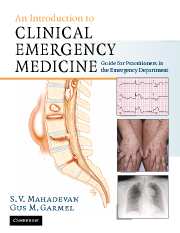Book contents
- Frontmatter
- Contents
- List of contributors
- Foreword
- Acknowledgments
- Dedication
- Section 1 Principles of Emergency Medicine
- Section 2 Primary Complaints
- 9 Abdominal pain
- 10 Abnormal behavior
- 11 Allergic reactions and anaphylactic syndromes
- 12 Altered mental status
- 13 Chest pain
- 14 Constipation
- 15 Crying and irritability
- 16 Diabetes-related emergencies
- 17 Diarrhea
- 18 Dizziness and vertigo
- 19 Ear pain, nosebleed and throat pain (ENT)
- 20 Extremity trauma
- 21 Eye pain, redness and visual loss
- 22 Fever in adults
- 23 Fever in children
- 24 Gastrointestinal bleeding
- 25 Headache
- 26 Hypertensive urgencies and emergencies
- 27 Joint pain
- 28 Low back pain
- 29 Pelvic pain
- 30 Rash
- 31 Scrotal pain
- 32 Seizures
- 33 Shortness of breath in adults
- 34 Shortness of breath in children
- 35 Syncope
- 36 Toxicologic emergencies
- 37 Urinary-related complaints
- 38 Vaginal bleeding
- 39 Vomiting
- 40 Weakness
- Section 3 Unique Issues in Emergency Medicine
- Section 4 Appendices
- Index
34 - Shortness of breath in children
Published online by Cambridge University Press: 27 October 2009
- Frontmatter
- Contents
- List of contributors
- Foreword
- Acknowledgments
- Dedication
- Section 1 Principles of Emergency Medicine
- Section 2 Primary Complaints
- 9 Abdominal pain
- 10 Abnormal behavior
- 11 Allergic reactions and anaphylactic syndromes
- 12 Altered mental status
- 13 Chest pain
- 14 Constipation
- 15 Crying and irritability
- 16 Diabetes-related emergencies
- 17 Diarrhea
- 18 Dizziness and vertigo
- 19 Ear pain, nosebleed and throat pain (ENT)
- 20 Extremity trauma
- 21 Eye pain, redness and visual loss
- 22 Fever in adults
- 23 Fever in children
- 24 Gastrointestinal bleeding
- 25 Headache
- 26 Hypertensive urgencies and emergencies
- 27 Joint pain
- 28 Low back pain
- 29 Pelvic pain
- 30 Rash
- 31 Scrotal pain
- 32 Seizures
- 33 Shortness of breath in adults
- 34 Shortness of breath in children
- 35 Syncope
- 36 Toxicologic emergencies
- 37 Urinary-related complaints
- 38 Vaginal bleeding
- 39 Vomiting
- 40 Weakness
- Section 3 Unique Issues in Emergency Medicine
- Section 4 Appendices
- Index
Summary
Scope of the problem
Difficulty breathing is one of the most common reasons for children to visit the emergency department (ED). In the US, tens of thousands of children are hospitalized for respiratory problems each year. In the winter, most emergency physicians will likely evaluate several children with difficulty breathing a day. The needed interventions can be as simple as reassurance for a head cold to intubation for respiratory failure. The outcomes vary considerably. Although most children recover completely from episodes of difficulty breathing, permanent lung or brain injury and death may occur, typically in very young infants or chronically-ill children.
Anatomic essentials
Infants and young children have relatively narrow airways, with high resistance. If the diameter of these small airways is decreased, the work of breathing can increase dramatically. The airways can narrow due to inflammation (e.g., asthma, chemical pneumonitis, bacterial tracheitis, croup), bronchospasm (e.g., asthma, bronchiolitis), extrinsic compression (e.g., esophageal foreign body, retropharyngeal abscess), excessive mucus and secretions with airway plugging (e.g., bronchiolitis, bacterial tracheitis, pneumonia) or mechanical obstruction (e.g., aspirated foreign body). Infants have a pliable chest wall and immature diaphragm which also contribute to respiratory fatigue and failure. Increased work of breathing may cause a child to be unable to feed with resultant dehydration or respiratory muscle fatigue leading to respiratory failure and mechanical ventilation.
History
Conditions that cause difficulty breathing in children have many similar features. Many are preceded by rhinorrhea, low-grade fever, and other symptoms of upper respiratory tract infection.
- Type
- Chapter
- Information
- An Introduction to Clinical Emergency MedicineGuide for Practitioners in the Emergency Department, pp. 503 - 516Publisher: Cambridge University PressPrint publication year: 2005



